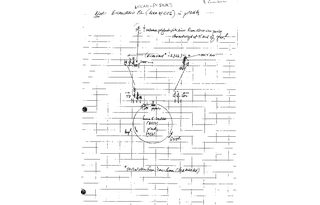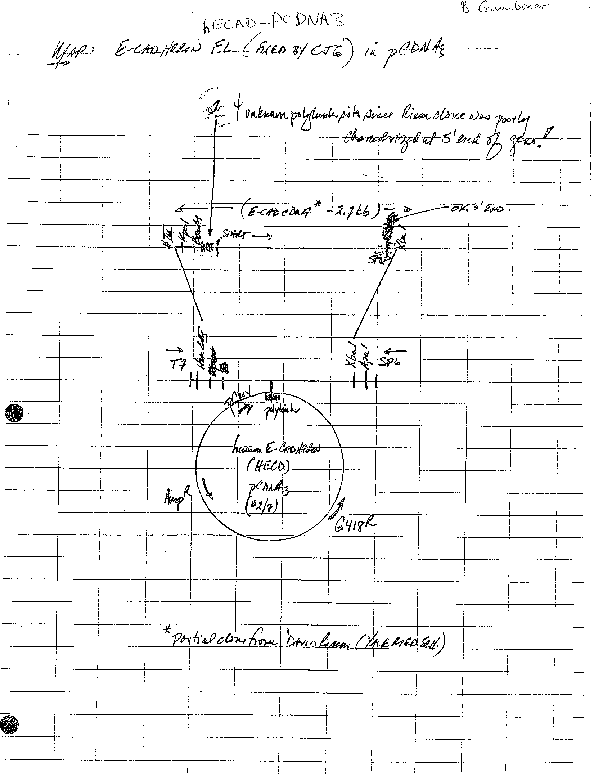-
Depositing Lab
-
Publication
-
Sequence Information
Ordering
| Item | Catalog # | Description | Quantity | Price (USD) | |
|---|---|---|---|---|---|
| Plasmid | 45769 | Standard format: Plasmid sent in bacteria as agar stab | 1 | $85 | |
Backbone
-
Vector backbonepcDNA3
-
Backbone manufacturerInvitrogen
- Backbone size w/o insert (bp) 5446
- Total vector size (bp) 8550
-
Vector typeMammalian Expression
-
Selectable markersNeomycin (select with G418)
Growth in Bacteria
-
Bacterial Resistance(s)Ampicillin, 100 μg/mL
-
Growth Temperature37°C
-
Growth Strain(s)DH5alpha
-
Copy numberHigh Copy
Gene/Insert
-
Gene/Insert namehE-cadherin
-
Alt nameE-cadherin
-
Alt nameCDH-1
-
SpeciesH. sapiens (human)
-
Insert Size (bp)3100
-
GenBank IDNM_004360.4 NP_004351.1
-
Entrez GeneCDH1 (a.k.a. Arc-1, BCDS1, CD324, CDHE, ECAD, LCAM, UVO)
- Promoter CMV
Cloning Information
- Cloning method Restriction Enzyme
- 5′ cloning site HindIII (not destroyed)
- 3′ cloning site XbaI (not destroyed)
- 5′ sequencing primer CMV-F; T7
- 3′ sequencing primer BGH-rev; Sp6 (Common Sequencing Primers)
Resource Information
-
A portion of this plasmid was derived from a plasmid made byHuman E-cadherin partial cDNA provided by David Rimm (Yale University, New Haven, CT)
-
Articles Citing this Plasmid
Terms and Licenses
-
Academic/Nonprofit Terms
-
Industry Terms
- Not Available to Industry
Trademarks:
- Zeocin® is an InvivoGen trademark.
Depositor Comments
Partial cDNA for human E-cadherin was provided by D. Rimm (Yale University, New Haven, CT) and subcloned into the pcDNA3 mammalian expression vector (Invitrogen), to generate Addgene plasmid 45772. Sequence analysis revealed that the 3′ end of the gene was missing after nucleotide 2644 (according to EMBL/GenBank/DDBJ under accession number L08599). This resulted in a truncation of the last 35 amino acids of the E-cadherin cytoplasmic domain and, as a result, did not contain the β-catenin binding region, as defined by Stappert and Kemler 1994. The COOH terminus of this truncation mutant (E-cadherin Δ β-catenin) ends at amino acid 844 (NH3-ASLSSD); the frameshift added a single histidine residue before a stop codon is introduced.
The full-length human E-cadherin was reengineered using RNA from human A431 cells and the RT-PCR method
(Primer A, 5′-TGACACCCGGGACAACGTTTATTA-3′, and Primer C, 5′-CTAGTCTAGACCCCTAGTGGTCCTCG-3′)
to generate a 425-bp fragment encoding the missing COOH-terminal residues. This fragment was sub-cloned into the truncated hEcad-Δ 35/pcDNA3 vector (Addgene plasmid 45772) to generate full-length hEcad/pcDNA3 (Addgene plasmid 45769).
These plasmids were created by your colleagues. Please acknowledge the Principal Investigator, cite the article in which the plasmids were described, and include Addgene in the Materials and Methods of your future publications.
-
For your Materials & Methods section:
hE-cadherin-pcDNA3 was a gift from Barry Gumbiner (Addgene plasmid # 45769 ; http://n2t.net/addgene:45769 ; RRID:Addgene_45769) -
For your References section:
E-cadherin suppresses cellular transformation by inhibiting beta-catenin signaling in an adhesion-independent manner. Gottardi CJ, Wong E, Gumbiner BM. J Cell Biol. 2001 May 28;153(5):1049-60. 10.1083/jcb.153.5.1049 PubMed 11381089









